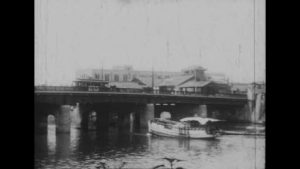Hiroshima Peace Memorial Museum website presents film footage of daily life in Hiroshima before A-bombing
Mar. 29, 2019
(by Junji Akechi, Staff Writer)
The Hiroshima Peace Memorial Museum, located in Naka Ward, has digitized film footage that shows scenes from around 1934, before the A-bomb attack, which includes life in downtown Hiroshima and people swimming at the beach on the outskirts of the city. The museum is now presenting this footage on its website. Family members of the late Hideo Inoue, who took this footage, donated it to the museum in 2017. The museum is also including the footage as “important images which depict Hiroshima before the war” at the New Arrivals Exhibition, starting on March 29.
The footage shot by Mr. Inoue consists of two 9.5 mm films that last about seven minutes in total. It shows not only the Hatchobori neighborhood, streetcars running on the Aioi Bridge, and boats with simple steam impellers chugging down the Honkawa River, but also the bustle of the swimming area in Itsukaichi-cho (now part of Saeki Ward) where he went with his family. He also captured soldiers in procession carrying what looks like a field gun in a cart pulled by horses, which conveys the fact that Hiroshima was a military city at the time.
Mr. Inoue’s eldest son, Setsuo Inoue (who died in 2015 at the age of 85), who appears in the films, kept them for many years as mementos of his family. His wife, Kazuko Inoue, 87, a resident of the city of Nishinomiya, Hyogo Prefecture, then inherited them and when she learned from a news report that the Peace Memorial Museum is preserving and presenting other films, she decided to donate the films to the museum in 2017. She said that she had heard films showing Hiroshima before the atomic bombing were important and she thought that other people might want to watch them. She also said that she wanted the films to be put to a positive use to learn about the ambience of the old days.
Regarding films held by the museum that show scenes of Hiroshima before the war, there had been only one other original film, about three minutes in length, that was donated in 1963. The museum has digitized the films it holds, including the two films shot by Mr. Inoue, and is presenting them in videos on its website “Peace Database.” A museum curator said that the films depict the daily lives of citizens back then, such as people who enjoyed swimming at the beach on the weekend, and enable us to again recognize the scale and significance of all that was lost because of the atomic bomb.
(Originally published on March 29, 2019)
The Hiroshima Peace Memorial Museum, located in Naka Ward, has digitized film footage that shows scenes from around 1934, before the A-bomb attack, which includes life in downtown Hiroshima and people swimming at the beach on the outskirts of the city. The museum is now presenting this footage on its website. Family members of the late Hideo Inoue, who took this footage, donated it to the museum in 2017. The museum is also including the footage as “important images which depict Hiroshima before the war” at the New Arrivals Exhibition, starting on March 29.
The footage shot by Mr. Inoue consists of two 9.5 mm films that last about seven minutes in total. It shows not only the Hatchobori neighborhood, streetcars running on the Aioi Bridge, and boats with simple steam impellers chugging down the Honkawa River, but also the bustle of the swimming area in Itsukaichi-cho (now part of Saeki Ward) where he went with his family. He also captured soldiers in procession carrying what looks like a field gun in a cart pulled by horses, which conveys the fact that Hiroshima was a military city at the time.
Mr. Inoue’s eldest son, Setsuo Inoue (who died in 2015 at the age of 85), who appears in the films, kept them for many years as mementos of his family. His wife, Kazuko Inoue, 87, a resident of the city of Nishinomiya, Hyogo Prefecture, then inherited them and when she learned from a news report that the Peace Memorial Museum is preserving and presenting other films, she decided to donate the films to the museum in 2017. She said that she had heard films showing Hiroshima before the atomic bombing were important and she thought that other people might want to watch them. She also said that she wanted the films to be put to a positive use to learn about the ambience of the old days.
Regarding films held by the museum that show scenes of Hiroshima before the war, there had been only one other original film, about three minutes in length, that was donated in 1963. The museum has digitized the films it holds, including the two films shot by Mr. Inoue, and is presenting them in videos on its website “Peace Database.” A museum curator said that the films depict the daily lives of citizens back then, such as people who enjoyed swimming at the beach on the weekend, and enable us to again recognize the scale and significance of all that was lost because of the atomic bomb.
(Originally published on March 29, 2019)








